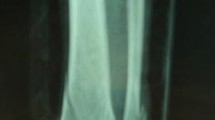Abstract
Ninety-eight pilon fractures associated with ipsilateral distal fibular fracture were included in this study. The pilon fractures were treated by open reduction and plating. The 98 fractures were divided into three groups based on the treatment method of fractured fibula. Group A was composed of 50 fibular fractures treated by open reduction and plate fixation. Group B was composed of 23 fibular fractures treated by open reduction and pin fixation. Group C was composed of 25 fibular fractures treated conservatively by closed reduction. The radiographs were reviewed for adequacy of fracture reduction and posttraumatic arthrosis. At the end of follow-up, the clinical outcomes were evaluated using a rating scale. The three groups were similar in respect to Ruedi type, open fracture grade, and demographics (all p values >0.25). Group A showed a decreasing trend of malunion and ankle arthrosis compared to group C (p = 0.091 and p = 0.099, respectively). Group A had a better clinical outcome than group C (p = 0.008). In addition, group A showed an increasing trend of satisfactory outcome compared to group B (p = 0.096). In conclusion, for pilon fractures associated with ipsilateral fibular fractures, stabilisation of the fractured fibula plays an important role in the decrease of distal tibial malunion and post-traumatic ankle arthrosis as well as improvement of clinical outcomes.
Résumé
98 fractures du pilon tibial avec fracture du péroné ont été inclus dans cette étude. Les fractures du pilon tibial ont été traitées par réduction sanglante et ostéosynthèse par plaque. Les 98 fractures ont été divisées en 3 groupes selon les méthodes de traitement du péroné fracturé. Le groupe A était composé de 50 fractures du péroné traitées par réduction sanglante et plaque, le groupe B de 23 fractures du péroné traitées par réduction sanglante et fixations par broches et le groupe C de 25 fractures du péroné qui ont été réduites sans fixation. Les radiographies ont été analysées afin d’évaluer la réduction de la fracture et l’évolution vers une arthrose post-traumatique. A la fin du suivi, les trois groupes étaient identiques sur le plan clinique le type de Ruedi, le stade d’ouverture et les données démographiques. Le groupe A montrait un nombre moins important de pseudarthrose et d’arthrose de la cheville comparé au groupe C (p = 0,091, p = 0,099 respectivement). Le groupe A avait un meilleur résultat clinique que le groupe C (p = 0,008). De plus, le groupe A montrait une amélioration plus satisfaisante sur le devenir clinique à long terme que le groupe B (p = 0,096). En conclusion, les fractures du pilon tibial présentant une fracture associée du péroné doivent être stabilisées au niveau du tibia et au niveau du péroné par une ostéosynthèse par plaques de façon à diminuer le nombre de cals vicieux postraumatiques et d’améliorer les résultats cliniques.

Similar content being viewed by others
References
Ayeni JP (1988) Pilon fractures of the tibia: a study based on 19 cases. Injury 19:109–114
Barei DP, Nork SE, Bellabarba C et al (2006) Is the absence of an ipsilateral fibular fracture predictive of increased radiographic tibial pilon fracture severity? J Orthop Trauma 20(1):6–10
Bourne RB (1989) Pilon fractures of the distal tibia. Clin Orthop 240:42–46
Chen SH, Wu PH, Lee YS (2007) Long-term results of pilon fractures. Arch Orthop Trauma Surg 127(1):55–60
Conroy J, Agarwal M, Giannoudis PV et al (2003) Early internal fixation and soft tissue cover of severe open tibial pilon fractures. Int Orthop 27:343–347
Helfet DL, Koval K, Pappas J et al (1994) Intra-articular “pilon” fracture of the tibia. Clin Orthop 298:221–228
Leonard M, Magill P, Khayyat G (2008) Minimally-invasive treatment of high velocity intra-articular fractures of the distal tibia. Int Orthop Jul 25. [Epub ahead of print]
Lee YS, Huang HL, Lo TY et al (2007) Lateral fixation of AO type-B2 ankle fractures in the elderly: the Knowles pin versus the plate. Int Orthop 31:817–821
Leung F, Kwok HY, Pun TS et al (2004) Limited open reduction and Ilizarov external fixation in the treatment of distal tibial fractures. Injury 35:278–283
Mclennan JG, Ungersma JA (1986) A new approach to the treatment of ankle fractures. Clin Orthop 213:125–136
Ovadia DN, Beals RK (1986) Fractures of the tibial plafond. J Bone Joint Surg Am 68:543–551
Patterson MJ, Cole JD (1999) Two-staged delayed open reduction and internal fixation of severe pilon fractures. J Orthop Trauma 13:85–91
Phillips WA, Schwartz HS, Keller CS et al (1985) A prospective randomized study of the management of severe ankle fractures. J Bone Joint Surg Am 67:67–78
Pollak AN, McCarthy ML, Bess RS et al (2003) Outcomes after treatment of high-energy tibial plafond fractures. J Bone Joint Surg Am 85:1893–1900
Ruedi TP, Allgower M (1969) Fractures of the lower end of the tibia into the ankle joint. Injury 1:92–99
Ruedi TP, Allgower M (1979) The operative treatment of intra-articular fractures of the lower end of the tibia. Clin Orthop 138:105–110
Sirkin M, Sanders R, DiPasquale T et al (2004) A staged protocol for soft tissue management in the treatment of complex pilon fractures. J Orthop Trauma 18(8 suppl):S32–S38
Teeny SM, Wiss DA (1993) Open reduction and internal fixation of tibial plafond fractures. Clin Orthop 292:108–117
Topliss CJ, Jackson M, Atkins RM (2005) Anatomy of pilon fractures of the distal tibia. J Bone Joint Surg Br 87:692–697
Author information
Authors and Affiliations
Corresponding author
Rights and permissions
About this article
Cite this article
Lee, YS., Chen, SW., Chen, SH. et al. Stabilisation of the fractured fibula plays an important role in the treatment of pilon fractures: a retrospective comparison of fibular fixation methods. International Orthopaedics (SICOT) 33, 695–699 (2009). https://doi.org/10.1007/s00264-008-0654-4
Received:
Revised:
Accepted:
Published:
Issue Date:
DOI: https://doi.org/10.1007/s00264-008-0654-4




